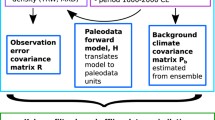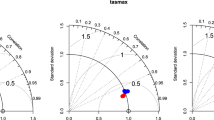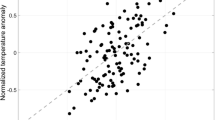Abstract
Monthly mean fields of temperature and geopotential height (GPH) from 700 to 100 hPa were statistically reconstructed for the extratropical Northern Hemisphere for the World War II period. The reconstruction was based on several hundred predictor variables, comprising temperature series from meteorological stations and gridded sea level pressure data (1939-1947) as well as a large amount of historical upper-air data (1939-1944). Statistical models were fitted in a calibration period (1948-1994) using the NCEP/NCAR Reanalysis data set as predictand. The procedure consists of a weighting scheme, principal component analyses on both the predictor variables and the predictand fields and multiple regression models relating the two sets of principal component time series to each other. According to validation experiments, the reconstruction skill in the 1939-1944 period is excellent for GPH at all levels and good for temperature up to 500 hPa, but somewhat worse for 300 hPa temperature and clearly worse for 100 hPa temperature. Regionally, high predictive skill is found over the midlatitudes of Europe and North America, but a lower quality over Asia, the subtropics, and the Arctic. Moreover, the quality is considerably better in winter than in summer. In the 1945-1947 period, reconstructions are useful up to 300 hPa for GPH and, in winter, up to 500 hPa for temperature. The reconstructed fields are presented for selected months and analysed from a dynamical perspective. It is demonstrated that the reconstructions provide a useful tool for the analysis of large-scale circulation features as well as stratosphere-troposphere coupling in the late 1930s and early 1940s.






Similar content being viewed by others
References
Ambaum MHP, Hoskins BJ (2002) The NAO troposphere-stratosphere connection. J Clim 15: 1969-1978
Barnston AG, Livezey RE (1987) Classification, seasonality and persistence of low-frequency atmospheric circulation patterns. Mon Weather Rev 115: 1083-1126
Brönnimann S (2003a) Description of the 1939-1944 upper-air data set (UA39_44) Version 1.0. University of Arizona, Tucson, USA, pp 40
Brönnimann S (2003b) A historical upper-air data set for the 1939-1944 period. Int J Climatol 23: 769-791 DOI 10.1002/joc.914
Brönnimann S, Luterbacher J, Schmutz C, Wanner H, Staehelin J (2000) Variability of total ozone at Arosa, Switzerland, since 1931 related to atmospheric circulation indices. Geophys Res Lett 27: 2213-2216
Christy JR, Spencer RW, Norris WB, Braswell WD Parker DE (2003) Error estimates of Version 5.0 of MSU/AMSU bulk atmospheric temperatures. J Atmos Oceanic Tech 20: 613-629
Cook ER, Briffa KR, Jones PD (1994) Spatial regression methods in dendroclimatology - a review and comparison of two techniques. Int J Climatol 14: 379-402
Hartmann DL, Wallace JM, Limpasuvan V, Thompson DWJ, Holton JR (2000) Can ozone depletion and greenhouse warming interact to produce rapid climate change? Proc Natl Acad Sci USA 97: 1412-1417
Hansen J, Ruedy R, Sato M, Imhoff M, Lawrence W, Easterling D, Peterson T, Karl T (2001) A closer look at United States and global surface temperature change. J Geophys Res 106: 23,947-23,963
Hansen J, Ruedy R, Glascoe J, Sato M (1999) GISS analysis of surface temperature change. J Geophys Res 104: 30997-31022
Hurrell J, Kushnir Y, Ottersen G, Visbeck M (eds) (2003) The North Atlantic Oscillation. Climatic significance and environmental impact. AGU, Geophysical Monograph Series 134, Washington DC, USA
Kalnay E et al (1996) The NCEP/NCAR 40-year reanalysis project. Bull Am Meteorol Soc 77: 437-471
Karl TR, Williams CN Jr, Quinlan FT, Boden TA (1990) United States Historical Climatology Network (HCN) Serial Temperature and Precipitation Data, Environmental Science Division, Publication No. 3404, Carbon Dioxide Information and Analysis Center, Oak Ridge National Laboratory, Oak Ridge, TN, pp 389
Kington JA (1975) The construction of 500-millibar charts for the eastern North Atlantic-European sector from 1781. Meteorol Mag 104: 336-340
Kistler R et al (2001) The NCEP-NCAR 50-year reanalysis: monthly means CD-ROM and documentation. Bull Am Meteorol Soc 82: 247-267
Klein WH, Dai Y (1998) Reconstruction of monthly mean 700-mb heights from surface data by reverse specification. J Clim 11: 2136-2146
Labitzke K, Naujokat B (2000) The lower Arctic stratosphere in winter since 1952. SPARC Newslett 15: 11-14
Labitzke K et al (2002) The Berlin Stratospheric Data Series, CD from Meteorological Institute, Free University Berlin, Germany
Lanzante JR, Klein SA, Seidel DJ (2003) Temporal homogenization of monthly radiosonde temperature data. Part I: methodology. J Clim 16: 224-240
Limpasuvan V, Thompson DWJ, Hartmann DL (2004) On the life cycle of Northern Hemisphere stratospheric sudden warming. J Clim (in press)
Lorenz EN (1956) Empirical orthogonal functions and statistical weather prediction. M.I.T. Statistical Forecasting Project Report 1, Contract AF 19: 604-1566
Luterbacher J, Xoplaki E, Dietrich D, Rickli R, Jacobeit J, Beck C, Gyalistras D, Schmutz C, Wanner H (2002) Reconstruction of sea-level pressure fields over the eastern North Atlantic and Europe back to 1500. Clim Dyn 18: 545-561 DOI 10.1007/s00382-001-0196-6
Mears C, Schabel M, Wentz F (2003) A reanalysis of the MSU Channel 2 tropospheric temperature record. J Clim 16:3650-3664
Parker DE, Gordon M, Cullum DPN, Sexton DMH, Folland CK, Rayner N (1997) A new gridded radiosonde temperature data base and recent temperature trends. Geophys Res Lett 24: 1499-1502
Peterson TC, Vose RS (1997) An overview of the Global Historical Climatology Network temperature data base. Bull Am Meteorol Soc 78: 2837-2849
Polansky BC (2002) Reconstructing 500-hPa height fields over the Northern Hemisphere. Msc Thesis, University of Washington, Seattle. USA, pp 38
Polvani LM, Waugh DW (2004) Upward wave activity flux as precursor to extreme stratospheric events and subsequent anomalous surface weather regimes. J Clim (in press)
Randel WJ, Wu F, Gaffen DJ (2000) Interannual variability of the tropical tropopause from radiosonde data and NCEP reanalysis. J Geophys Res 105: 15,509-15,523
Santer BD, Hnilo JJ, Wigley TML, Boyle JS, Doutriaux C, Fiorino M, Parker DE, Taylor KE (1999) Uncertainties in observationally based estimates of temperature change in the free atmosphere. J Geophys Res 104: 6305-6333
Schmutz C, Gyalistras D, Luterbacher J, Wanner H (2001) Reconstruction of monthly 700, 500 and 300 hPa geopotential height fields in the European and Eastern North Atlantic region for the period 1901-1947. Clim Res 18: 181-193
Thompson DWJ, Wallace JM (1998) The Arctic Oscillation signature in the wintertime geopotential height and temperature fields. Geophys Res Lett 25: 1297-1300
Trenberth KE, Paolino DA (1980) The Northern Hemisphere sea level pressure data set: trends, errors, and discontinuities. Mon Weather Rev 108: 855-872
Wanner H, Brönnimann S, Casty C, Gyalistras D, Luterbacher J, Schmutz C, Stephenson D, Xoplaki E (2001) North Atlantic Oscillation - concept and studies. Surv Geophys 22: 321-381
Acknowledgements
S.B. was funded by the Swiss National Science Foundation and the Holderbank-Foundation. J.L. was funded by the Swiss National Competence Center for Research in Climate. Support by the Stiftung Marchese Francseco Medici del Vascello is gratefully acknowledged. The reconstructed fields and corresponding error measures as well as the historical upper-air data and detailed documentation can be downloaded from the website http://sinus.unibe.ch/~broenn/UA39_44/. The authors wish to thank D. Dietrich (Univ. Bern) for statistical advice.
Author information
Authors and Affiliations
Corresponding author
Electronic Supplementary Material
Rights and permissions
About this article
Cite this article
Brönnimann, S., Luterbacher, J. Reconstructing Northern Hemisphere upper-level fields during World War II. Climate Dynamics 22, 499–510 (2004). https://doi.org/10.1007/s00382-004-0391-3
Received:
Accepted:
Published:
Issue Date:
DOI: https://doi.org/10.1007/s00382-004-0391-3




